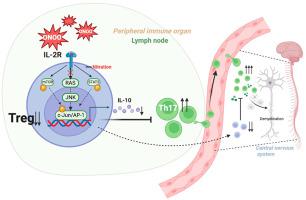当前位置:
X-MOL 学术
›
Redox Biol.
›
论文详情
Our official English website, www.x-mol.net, welcomes your feedback! (Note: you will need to create a separate account there.)
Peroxynitrite reduces Treg cell expansion and function by mediating IL-2R nitration and aggravates multiple sclerosis pathogenesis
Redox Biology ( IF 10.7 ) Pub Date : 2024-06-15 , DOI: 10.1016/j.redox.2024.103240 Meiling Wu 1 , Sulan Yu 2 , Shenyu Yan 1 , Minghui Wu 3 , Lu Zhang 1 , Shuang Chen 1 , Dongyun Shi 4 , Shanlin Liu 5 , Yongping Fan 3 , Xiang Lin 1 , Jiangang Shen 1
Redox Biology ( IF 10.7 ) Pub Date : 2024-06-15 , DOI: 10.1016/j.redox.2024.103240 Meiling Wu 1 , Sulan Yu 2 , Shenyu Yan 1 , Minghui Wu 3 , Lu Zhang 1 , Shuang Chen 1 , Dongyun Shi 4 , Shanlin Liu 5 , Yongping Fan 3 , Xiang Lin 1 , Jiangang Shen 1
Affiliation

|
T-helper 17 cells and regulatory T cells (Treg) are critical regulators in the pathogenesis of multiple sclerosis (MS) but the factors affecting Treg/Th17 balance remains largely unknown. Redox balance is crucial to maintaining immune homeostasis and reducing the severity of MS but the underlying mechanisms are unclear yet. Herein, we tested the hypothesis that peroxynitrite, a representative molecule of reactive nitrogen species (RNS), could inhibit peripheral Treg cells, disrupt Treg/Th17 balance and aggravate MS pathology by inducing nitration of interleukin-2 receptor (IL-2R) and down-regulating RAS/JNK-AP-1 signalling pathway. Experimental autoimmune encephalomyelitis (EAE) mouse model and serum samples of MS patients were used in the study. We found that the increases of 3-nitrotyrosine and IL-2R nitration in Treg cells were coincided with disease severity in the active EAE mice. Mechanistically, peroxynitrite-induced IL-2R nitration down-regulated RAS/JNK signalling pathway, subsequently impairing peripheral Treg expansion and function, increasing Teff infiltration into the central nerve system (CNS), aggravating demyelination and neurological deficits in the EAE mice. Those changes were abolished by peroxynitrite decomposition catalyst (PDC) treatment. Furthermore, transplantation of the PDC-treated-autologous Treg cells from donor EAE mice significantly decreased Th17 cells in both axillary lymph nodes and lumbar spinal cord, and ameliorated the neuropathology of the recipient EAE mice. Those results suggest that peroxynitrite could disrupt peripheral Treg/Th17 balance, and aggravate neuroinflammation and neurological deficit in active EAE/MS pathogenesis. The underlying mechanisms are related to induce the nitration of IL-2R and inhibit the RAS/JNK-AP-1 signalling pathway in Treg cells. The study highlights that targeting peroxynitrite-mediated peripheral IL-2R nitration in Treg cells could be a novel therapeutic strategy to restore Treg/Th17 balance and ameliorate MS/EAE pathogenesis. The study provides valuable insights into potential role of peripheral redox balance in maintaining CNS immune homeostasis.
中文翻译:

过氧亚硝酸盐通过介导 IL-2R 硝化降低 Treg 细胞的扩增和功能,并加剧多发性硬化症的发病机制
辅助 T 细胞 17 和调节性 T 细胞 (Treg) 是多发性硬化症 (MS) 发病机制中的关键调节因子,但影响 Treg/Th17 平衡的因素仍然很大程度上未知。氧化还原平衡对于维持免疫稳态和降低多发性硬化症的严重程度至关重要,但其潜在机制尚不清楚。在此,我们测试了以下假设:过氧亚硝酸盐是活性氮 (RNS) 的代表分子,可通过诱导白细胞介素 2 受体 (IL-2R) 硝化和下调,抑制外周 Treg 细胞、破坏 Treg/Th17 平衡并加重 MS 病理。 -调节RAS/JNK-AP-1信号通路。研究中使用了实验性自身免疫性脑脊髓炎(EAE)小鼠模型和多发性硬化症患者的血清样本。我们发现 Treg 细胞中 3-硝基酪氨酸和 IL-2R 硝化的增加与活动性 EAE 小鼠的疾病严重程度相一致。从机制上讲,过氧亚硝酸盐诱导的IL-2R硝化下调了RAS/JNK信号通路,随后损害了外周Treg的扩张和功能,增加了Teff对中枢神经系统(CNS)的浸润,加剧了EAE小鼠的脱髓鞘和神经功能缺损。这些变化被过氧亚硝酸盐分解催化剂(PDC)处理所消除。此外,移植来自供体EAE小鼠的经PDC处理的自体Treg细胞显着减少了腋窝淋巴结和腰脊髓中的Th17细胞,并改善了受体EAE小鼠的神经病理学。这些结果表明,过氧亚硝酸盐可能会破坏外周 Treg/Th17 平衡,并加重活动性 EAE/MS 发病机制中的神经炎症和神经功能缺损。 其潜在机制与诱导Treg细胞中IL-2R硝化并抑制RAS/JNK-AP-1信号通路有关。该研究强调,针对 Treg 细胞中过氧亚硝酸盐介导的外周 IL-2R 硝化可能是恢复 Treg/Th17 平衡和改善 MS/EAE 发病机制的新治疗策略。该研究为外周氧化还原平衡在维持中枢神经系统免疫稳态中的潜在作用提供了有价值的见解。
更新日期:2024-06-15
中文翻译:

过氧亚硝酸盐通过介导 IL-2R 硝化降低 Treg 细胞的扩增和功能,并加剧多发性硬化症的发病机制
辅助 T 细胞 17 和调节性 T 细胞 (Treg) 是多发性硬化症 (MS) 发病机制中的关键调节因子,但影响 Treg/Th17 平衡的因素仍然很大程度上未知。氧化还原平衡对于维持免疫稳态和降低多发性硬化症的严重程度至关重要,但其潜在机制尚不清楚。在此,我们测试了以下假设:过氧亚硝酸盐是活性氮 (RNS) 的代表分子,可通过诱导白细胞介素 2 受体 (IL-2R) 硝化和下调,抑制外周 Treg 细胞、破坏 Treg/Th17 平衡并加重 MS 病理。 -调节RAS/JNK-AP-1信号通路。研究中使用了实验性自身免疫性脑脊髓炎(EAE)小鼠模型和多发性硬化症患者的血清样本。我们发现 Treg 细胞中 3-硝基酪氨酸和 IL-2R 硝化的增加与活动性 EAE 小鼠的疾病严重程度相一致。从机制上讲,过氧亚硝酸盐诱导的IL-2R硝化下调了RAS/JNK信号通路,随后损害了外周Treg的扩张和功能,增加了Teff对中枢神经系统(CNS)的浸润,加剧了EAE小鼠的脱髓鞘和神经功能缺损。这些变化被过氧亚硝酸盐分解催化剂(PDC)处理所消除。此外,移植来自供体EAE小鼠的经PDC处理的自体Treg细胞显着减少了腋窝淋巴结和腰脊髓中的Th17细胞,并改善了受体EAE小鼠的神经病理学。这些结果表明,过氧亚硝酸盐可能会破坏外周 Treg/Th17 平衡,并加重活动性 EAE/MS 发病机制中的神经炎症和神经功能缺损。 其潜在机制与诱导Treg细胞中IL-2R硝化并抑制RAS/JNK-AP-1信号通路有关。该研究强调,针对 Treg 细胞中过氧亚硝酸盐介导的外周 IL-2R 硝化可能是恢复 Treg/Th17 平衡和改善 MS/EAE 发病机制的新治疗策略。该研究为外周氧化还原平衡在维持中枢神经系统免疫稳态中的潜在作用提供了有价值的见解。
















































 京公网安备 11010802027423号
京公网安备 11010802027423号